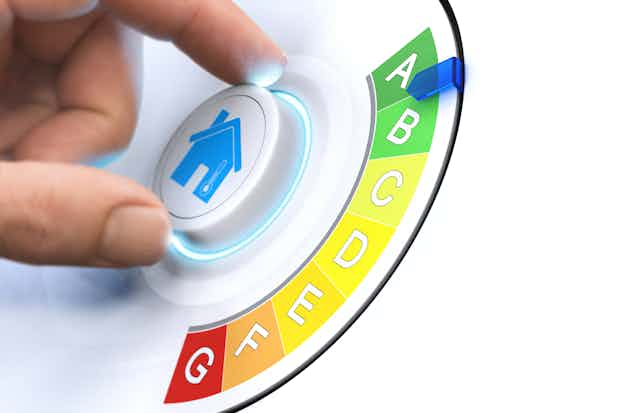Imagine heating your home from the ceiling, not from underfloor heating or radiators. Once installed like wallpaper, hi-tech infrared fabric emits heat in a similar way to the sun’s rays. This could be a logical way to add low-carbon heat into existing homes that need retrofitting to improve energy efficiency.
Under the currently proposed legislative changes, no new home will be built with an incoming gas supply after 2025. If you’re buying a new home that’s been designed and built to the new Future Homes Standard, you’ve got little to worry about.
But for older properties, retrofitting projects can be complex, inconvenient and expensive. As gas boilers are phased out, heat pumps are usually the preferred alternative for energy-efficient housing. However, infrared fabric technology could be much better suited as a low-carbon heating solution for our existing housing stock, and here’s why.
1. Instant heat
Unlike heat pumps, which are a slow response heating system, infrared fabric emits radiant heat that can be felt within minutes. That has multiple advantages.

Gas boilers heat up our rooms quickly so we don’t have to leave the heating on when we’re out, but heat pumps don’t work like that. Instead, they deliver a continuous low level of heat, so homes need to be well-insulated to retain that heat and airtight to stop draughts. But, without draughts, we’ll need a mechanical ventilation system to circulate fresh air.
Instant radiant heat reduces the need for all these additional interventions by directly heating the people and surfaces in a room rather than the air itself. It can be turned on or boosted to higher temperatures by motion sensors when you enter a room, with instant results. That means you only need to heat the rooms that you’re in, rather than an entire house.
2. Simple to install
Infrared fabric looks like a roll of slightly stiff wallpaper. It’s essentially a graphene sandwich, a thin film of carbon between two sheets of paper that conducts low voltage electricity and emits infrared heat, like the sun, but without the light or harmful ultraviolet.
A room’s ceiling area emits the right amount of heat for a room, making installation very simple in any property, irrespective of its construction, shape or size. It’s little more than a wallpapering job with a click together wiring connection. Your gas boiler could even be left in place for emergencies alongside it. By comparison, heat pump installation requires extensive additional works and sometimes a period of relocation.

3. Affordable heat
Infrared fabric is affordable to install and maintain due to its simplicity with a total cost of around £100 per sq metre for a full system. And it’s quite indestructible – it can have holes cut out of it and can get wet in floods without any danger to occupants or damage to the material. It’s also affordable to run.
Heat pumps are known to generate more energy than they use, up to three times as much, by taking low grade heat out of the air and compressing it. Infrared fabric can’t match that, but because radiant heat is instant, it’s only being emitted when needed in the rooms that you’re in, so even allowing for a hot water system the total energy use can be up to 20% less than from a heat pump.
4. Radiant heat is healthy and safe
Once the infrared heat warms the people, objects and surfaces that it touches, they in turn give off secondary heat through the process of convection. But the overall temperature is perceived to be 3˚C warmer than it actually is because people are being heated, as opposed to the air.
That’s both healthier and cheaper to sustain. Radiant heat also means the air carries fewer allergens due to reduced air movement – it’s the convection currents from traditional heating systems that stir up the dust and allergens.
Infrared panels do the same thing but from a 90˚C point source in your room and with less consistency. Radiators reach 60 – 70˚C, whereas infrared fabric emits a low-level heat (45˚C) over the whole area. Heat absorbed into the fabric of the building is retained for longer than warmed air, resulting in a more consistent room temperature across day and night.
5. Our homegrown future
Infrared fabric is a UK invention and it’s UK-manufactured. All we need now is for it to be UK accredited. That’s a long and expensive process, but the all important SAP Appendix Q certification is due in 2025 if not before. It already has BSEN (British Standard) approval as a large area low temperature emitter and it’s class A fire rated.
The Welsh government already funds its use in retrofit programmes following extensive trials across 270 homes. Further research is now needed to evidence the health, safety and carbon benefits that will strengthen the case even more for this form of heating.
So if you’re retrofitting an existing property as a home owner, private landlord, housing association or local authority, infrared fabric could be a low-risk, low-cost, low-carbon solution worth considering.

Don’t have time to read about climate change as much as you’d like?
Get a weekly roundup in your inbox instead. Every Wednesday, The Conversation’s environment editor writes Imagine, a short email that goes a little deeper into just one climate issue. Join the 30,000+ readers who’ve subscribed so far.

